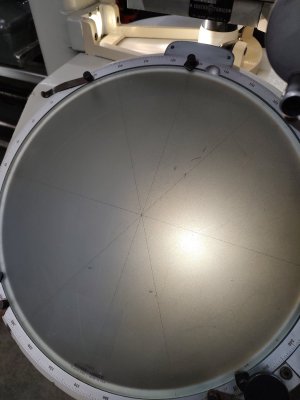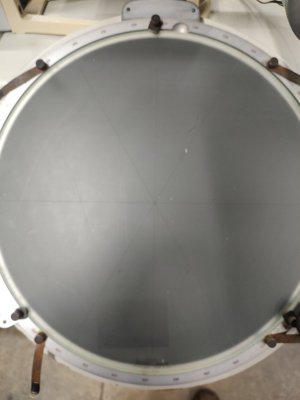-
Welcome back Guest! Did you know you can mentor other members here at H-M? If not, please check out our Relaunch of Hobby Machinist Mentoring Program!
You are using an out of date browser. It may not display this or other websites correctly.
You should upgrade or use an alternative browser.
You should upgrade or use an alternative browser.
Optical Comparator Advice
- Thread starter Arcstar*
- Start date
- Joined
- Nov 25, 2015
- Messages
- 9,594
that Micro Vue would be perfect for my needs.I have no idea what these are worth. But I attended an auction today. Saw a new-ish (2019) Mitutoyo sell for $6,750.

But then this Micro Vu sold for $35.00

I know there's a YUGE difference between the two besides the price tag, that's for sure. I'm not at the point in my journey with hobby machining that I am ready to step into this world.
I suppose for $350, you're on the right end of the curve.
Yeah to spendy for me but probably a dream machine for an aerospace shopthat Micro Vue would be perfect for my needs.
- Joined
- Nov 25, 2015
- Messages
- 9,594
The micro vue was $35 Lil Mule said. small and light on the wallet. I'm more about small and not using up much space. space that I don't have.Yeah to spendy for me but probably a dream machine for an aerospace shop
- Joined
- Oct 11, 2016
- Messages
- 4,004
@Arcstar* , you might consider printing an overlay on transparent Mylar printing medium, once you have calibrated it. this allows you to directly measure in single degrees and thousandths of an inch.
Does yours have a accurate rotate function? If so, then you don't really need it. If it doesn't then you print a radial graticle overlay to measure angles accurately.
Does yours have a accurate rotate function? If so, then you don't really need it. If it doesn't then you print a radial graticle overlay to measure angles accurately.
Thanks for the overlay idea. The guy I bought it from suggested purchasing the overlays from eBay.@Arcstar* , you might consider printing an overlay on transparent Mylar printing medium, once you have calibrated it. this allows you to directly measure in single degrees and thousandths of an inch.
Does yours have a accurate rotate function? If so, then you don't really need it. If it doesn't then you print a radial graticle overlay to measure angles accurately.
Accuracy of the rotation is unknown. Can you recommend the calibration process?
- Joined
- Oct 11, 2016
- Messages
- 4,004
Buy an inexpensive set of angle blocks from any supplier. The ones I've seen are well within and arcminute. You can calibrate your rotation function by selecting the 90 degree block - for the first step a 1-2-3 block is fine) . You align it with the 90 degree cross hairs on your machine, and rotate it around until it hits the next set of cross hairs. By counting the turns your can calibrate the dial. Doing a whole rotation or 10 rotations gets you more overall resolution, but doesn't aid the accuracy (this is an engineer thing).
Now you know how much 1 rotation of your handle is, and you can make a graduated bezel to read in even degrees, etc. If it isn't an even number of degrees, more creative solutions are required, and is out of the scope of a quick text answer.
The next step is to get yopur 5 degree angle block and dial in 5 degrees and make sure you made the bezel correctly, etc. Thus the need for angle blocks for about 20 bucks.
Now you know how much 1 rotation of your handle is, and you can make a graduated bezel to read in even degrees, etc. If it isn't an even number of degrees, more creative solutions are required, and is out of the scope of a quick text answer.
The next step is to get yopur 5 degree angle block and dial in 5 degrees and make sure you made the bezel correctly, etc. Thus the need for angle blocks for about 20 bucks.
I really you taking the time to help me with thisBuy an inexpensive set of angle blocks from any supplier. The ones I've seen are well within and arcminute. You can calibrate your rotation function by selecting the 90 degree block - for the first step a 1-2-3 block is fine) . You align it with the 90 degree cross hairs on your machine, and rotate it around until it hits the next set of cross hairs. By counting the turns your can calibrate the dial. Doing a whole rotation or 10 rotations gets you more overall resolution, but doesn't aid the accuracy (this is an engineer thing).
Now you know how much 1 rotation of your handle is, and you can make a graduated bezel to read in even degrees, etc. If it isn't an even number of degrees, more creative solutions are required, and is out of the scope of a quick text answer.
The next step is to get yopur 5 degree angle block and dial in 5 degrees and make sure you made the bezel correctly, etc. Thus the need for angle blocks for about 20 bucks.
https://www.tiktok.com/t/ZT8jsDjqH/
Here's a video of unloading it. If y'all want to check it out.
Here's a video of unloading it. If y'all want to check it out.
- Joined
- Nov 25, 2015
- Messages
- 9,594
oh wow, digital x y micrometer... sweet. I thought it was just a normal micrometer. you stole that.https://www.tiktok.com/t/ZT8jsDjqH/
Here's a video of unloading it. If y'all want to check it out.


